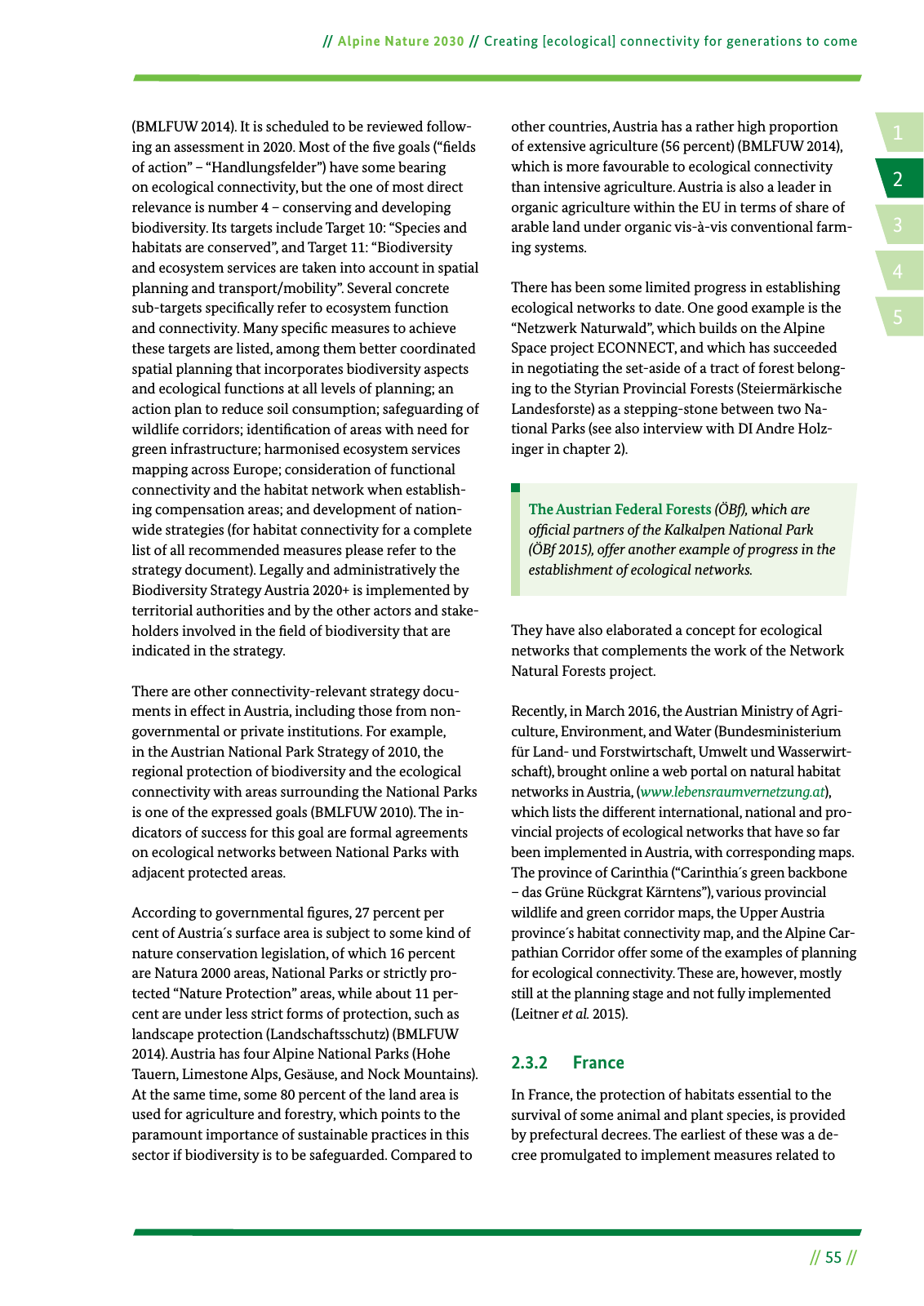14 2 5 3 55 Alpine Nature 2030 Creating ecological connectivity for generations to come BMLFUW 2014 It is scheduled to be reviewed follow ing an assessment in 2020 Most of the ve goals elds of action Handlungsfelder have some bearing on ecological connectivity but the one of most direct relevance is number 4 conserving and developing biodiversity Its targets include Target 10 Species and habitats are conserved and Target 11 Biodiversity and ecosystem services are taken into account in spatial planning and transport mobility Several concrete sub targets speci cally refer to ecosystem function and connectivity Many speci c measures to achieve these targets are listed among them better coordinated spatial planning that incorporates biodiversity aspects and ecological functions at all levels of planning an action plan to reduce soil consumption safeguarding of wildlife corridors identi cation of areas with need for green infrastructure harmonised ecosystem services mapping across Europe consideration of functional connectivity and the habitat network when establish ing compensation areas and development of nation wide strategies for habitat connectivity for a complete list of all recommended measures please refer to the strategy document Legally and administratively the Biodiversity Strategy Austria 2020 is implemented by territorial authorities and by the other actors and stake holders involved in the eld of biodiversity that are indicated in the strategy There are other connectivity relevant strategy docu ments in effect in Austria including those from non governmental or private institutions For example in the Austrian National Park Strategy of 2010 the regional protection of biodiversity and the ecological connectivity with areas surrounding the National Parks is one of the expressed goals BMLFUW 2010 The in dicators of success for this goal are formal agreements on ecological networks between National Parks with adjacent protected areas According to governmental gures 27 percent per cent of Austria s surface area is subject to some kind of nature conservation legislation of which 16 percent are Natura 2000 areas National Parks or strictly pro tected Nature Protection areas while about 11 per cent are under less strict forms of protection such as landscape protection Landschaftsschutz BMLFUW 2014 Austria has four Alpine National Parks Hohe Tauern Limestone Alps Gesäuse and Nock Mountains At the same time some 80 percent of the land area is used for agriculture and forestry which points to the paramount importance of sustainable practices in this sector if biodiversity is to be safeguarded Compared to other countries Austria has a rather high proportion of extensive agriculture 56 percent BMLFUW 2014 which is more favourable to ecological connectivity than intensive agriculture Austria is also a leader in organic agriculture within the EU in terms of share of arable land under organic vis à vis conventional farm ing systems There has been some limited progress in establishing ecological networks to date One good example is the Netzwerk Naturwald which builds on the Alpine Space project ECONNECT and which has succeeded in negotiating the set aside of a tract of forest belong ing to the Styrian Provincial Forests Steiermärkische Landesforste as a stepping stone between two Na tional Parks see also interview with DI Andre Holz inger in chapter 2 The Austrian Federal Forests ÖBf which are of cial partners of the Kalkalpen National Park ÖBf 2015 offer another example of progress in the establishment of ecological networks They have also elaborated a concept for ecological networks that complements the work of the Network Natural Forests project Recently in March 2016 the Austrian Ministry of Agri culture Environment and Water Bundesministerium für Land und Forstwirtschaft Umwelt und Wasserwirt schaft brought online a web portal on natural habitat networks in Austria www lebensraumvernetzung at which lists the different international national and pro vincial projects of ecological networks that have so far been implemented in Austria with corresponding maps The province of Carinthia Carinthia s green backbone das Grüne Rückgrat Kärntens various provincial wildlife and green corridor maps the Upper Austria province s habitat connectivity map and the Alpine Car pathian Corridor offer some of the examples of planning for ecological connectivity These are however mostly still at the planning stage and not fully implemented Leitner et al 2015 2 3 2 France In France the protection of habitats essential to the survival of some animal and plant species is provided by prefectural decrees The earliest of these was a de cree promulgated to implement measures related to

Hinweis: Dies ist eine maschinenlesbare No-Flash Ansicht.
Klicken Sie hier um zur Online-Version zu gelangen.
Klicken Sie hier um zur Online-Version zu gelangen.